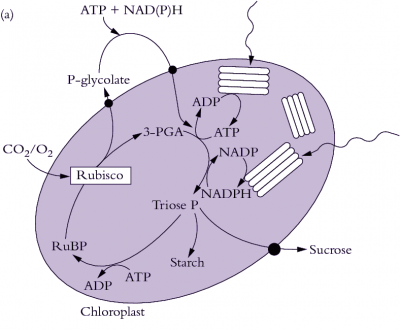Rubisco is a bifunctional enzyme capable of reacting either CO2 or O2 to RuBP in the active sites. Although Rubisco’s affinity for CO2 is an order of magnitude higher than that for O2, the high O2 concentration (20%) relative to CO2 (0.004%) in the Earth’s atmosphere leads to a ratio of 3:1 of carboxylation:oxygenation in C3 plants exposed to air. The carboxylation reaction yields two molecules of 3-PGA while the oxygenation of RuBP yields one molecule of 3-PGA and one molecule of phosphoglycolate (P-glycolate), as shown in this figure.
The 3-carbon compound 3-PGA enters the Calvin cycle, but the 2-carbon compound 2-phosphoglycolate is a dead-end metabolite. Consequently, plants have evolved a series of metabolic reactions, termed photorespiration, aimed at salvaging some of the carbon stored in 2-phosphogylcolate and evolving the rest as CO2. This process of CO2 evolution is different from mitochondrial respiration which is described in Section 2.4. The historical evidence for photorespiration is presented below.

